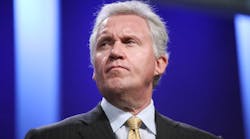Activist investor Nelson Peltz bought into General Electric Co. (IW 500/6) last year and went on to praise the growth potential he saw in the 124-year-old company’s shares. If he’s right, he’ll have to keep waiting.
The stock is coming off its worst quarter in more than two years, posting a 5.9% drop in the three months ending Sept. 30. With the decline, GE is trading around the same level it was in October 2015, after Peltz’s Trian Fund Management LP announced it had taken a $2.5 billion stake. The S&P 500 Index is up about 5% in that same span.
“You have earnings risk, high expectations and weak underlying free cash flow, which to me is a pretty bad formula for a stock,” said Steve Tusa, an analyst at JPMorgan Chase & Co. who in May cut his rating on GE to underweight. “What you have is a good franchise where people expect too much out of it.”
GE rallied last year as Chief Executive Officer Jeffrey Immelt led a major transformation, shedding finance units and completing GE’s largest-ever industrial acquisition to reorient the business around energy, aviation and oil. While the company has continued to evolve, with an increasing focus on software, GE hasn’t been able to sustain the enthusiasm through 2016.
When it reports third-quarter earnings this week, the Boston-based company will look to regain momentum and show investors that it can overcome a weak first half and persistently sluggish economy to deliver on growth expectations. That task became tougher after Honeywell International Inc. and Dover Corp. spooked industrial investors this month by trimming 2016 earnings forecasts.
“They both cited some general industrial slowing, so that has made everyone nervous about the industrials,” said Deane Dray, an analyst at RBC Capital Markets who rates GE outperform. “If you feel like the macro is getting tougher, then that’s going to be a tough environment for investors.”
Trian, which was co-founded by Peltz, Peter May and Ed Garden, last year revealed it held a roughly 1% stake in GE. The activist firm, which had been quietly buying shares for several months as GE traded in the mid-$20s, has taken a friendly and largely hands-off approach to the investment.
“We’re very aligned with management, very aligned with the board,” Garden told Bloomberg in an interview last month. Trian declined to comment for this article.
The move, seen as an endorsement of GE’s transformation strategy, generated a pop in the shares to almost $30 within two weeks. At the time, Trian said the stock, including dividends, could reach $45 a share by the end of 2017.
‘Optimistic’ Forecast
GE closed Tuesday at $28.98 in New York, exactly where it was one year ago. The shares climbed as high as $32.93 a share in 2016, but they’ve slid since July, when the company reported an orders decline that jeopardized its ability to hit aggressive growth targets.
The company has maintained its forecast of 2% to 4% organic growth for the year even as that metric fell 1% through the first six months and has remained weak across other industrial companies. Hitting the goal would require second-half growth of 5%, a target that “may be optimistic,” Karen Ubelhart, an analyst at Bloomberg Intelligence, said in a note.
GE executives have said 2016 will be heavily weighted to late in the year, with gas-turbine shipments boosting earnings in the fourth quarter. GE declined to comment further.
Analysts have cut expectations for third-quarter adjusted earnings by about 2 cents in the past four weeks to 30 cents a share, according to an average of 15 estimates compiled by Bloomberg. The persistent lowering of expectations will make better-than-forecast earnings less meaningful, particularly if orders and free cash flow remain weak, said Tusa of JPMorgan.
“It is a back end-loaded year, but it is a back end-loaded year that has undoubtedly, on an operating basis, been worse than expected,” said Tusa, whose price target is $28. As a result, investors are also questioning whether GE can achieve its earnings-per-share target of $2 in 2018, he said.
Dray of RBC called the $2 forecast achievable if GE can make progress in the coming quarters on several fronts, including integrating assets acquired last year from Alstom SA and keeping the oil-and-gas division from falling more sharply than expected.
GE’s prospects could depend less on near-term results and more on the ability to differentiate itself through its software business, according to Nicholas Heymann, an analyst at William Blair & Co. Lack of growth in the industrial sector has made such efforts critical, he said, and GE is making progress with its Predix operating system and efforts to expand the GE Digital division.
“This need to digitize to create customer and shareholder value is no longer optional and will require structural changes in the way industrial manufacturers create value,” Heymann, who rates GE outperform with a target of $38 a share, said in an Oct. 14 note. “GE is the vanguard of digitally enabled diversified industrials.”
By Richard Clough



